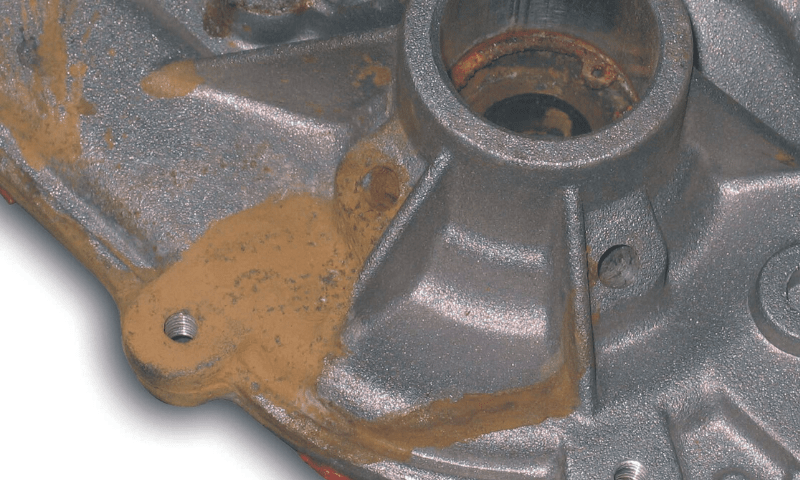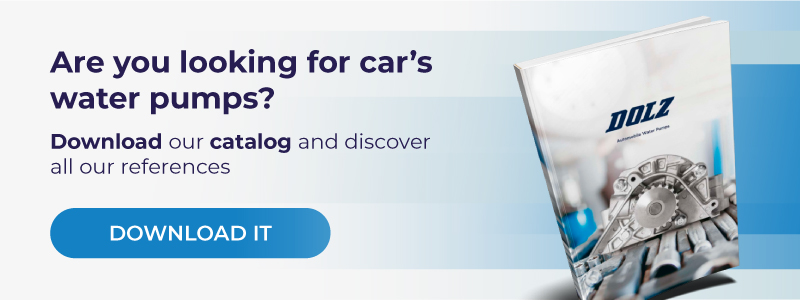The water pump acts as a central tool to the engine, playing a key role in a vehicle’s cooling system. To allow for a vehicle’s long life, preventive maintenance and thorough care must be taken seriously to avoid the water pump leaking and potential failure.
This article guides you through water pump leakage as a sign of engine malfunctioning, giving you all the necessary tips to prevent and react to water pump leakage and the resulting damage in the vehicle’s functioning and performance.
Water pump leaking: ¿What causes a water pump to leak?
1. Use of a wrong coolant liquid
A suitable coolant will be determined not only by the type of vehicle, but also by the climate and region where the vehicle is to be driven, thus, only the right coolant will fulfil its temperature-regulating mission.
Using the wrong refrigerant and/or mixing two different coolers can create solid residue in the circuit and cause leakage between the two contact faces of the dynamic seal. This will eventually lead to corrosive deposits that can generate clogging, cavitation damage and corrosion.
In order to choose the right coolant, it is essential to firmly consider expiry dates and follow vehicle manufacturer recommendations, as every individual engine is made of different materials and have specific needs.
2. Improper use of sealant paste
Sealant paste in water pumps is only necessary for those models that are provided without a gasket. If this is the case, be aware that the use of excessive sealant during the installation can damage the engine.
Applying the right amount of paste is crucial to avoid damaging the internal seal of the pump, as too much paste can create pollution in the system and damage the mechanical seal, resulting in water pump leakage and engine breakdown.
3. Inefficient water pump purging and/or dismantling
Never underestimate the degree to which a water pump impeller and housing design contributes to its efficiency. Most of the wear that occurs on a water pump is on the internal parts of the unit. Experts must remove, inspect, and clean individually all auxiliary and core devices, to accurately check for wear at central parts and ensure an optimum operating condition.
Dolz’s recommended purging machine
Micrauto’s high-end technology machines eliminate at least 90% of residues in only 20-45 minutes. A highly efficient purging system that eradicates from iron oxide, to aluminum oxide and other oil residues that might cause leakage.
4. Lack of preventive maintenance
Maintenance should be always carried out by qualified professionals with the skills, experience and necessary tools to inspect, adjust, replace and repair any components that are not performing as intended.
Beyond this, specialists must advise end users to dig a little deeper into the condition of their water pump by carrying out routinary checks and considering best practices such as the replacement of the water pump and distribution system at the same time for a long-lasting vehicle service.
In these ways, preventive rather than corrective maintenance allows the solving of existing faults before these affect pump performances. The following offer some of the most evident and popular signs of water pump failure.
Related content: Keys to choose the best water pump company
Common signs of water pump failure
1. Coolant leaking
One of the first signs and most evident indications of a potentially faulty water pump is a puddle of colored coolant on the ground right under your parked vehicle. If the sealing of the pump cracks or breaks, the coolant will leak from the pump.
In this case, it is advisable to drive your vehicle immediately to your closest mechanic for repairing, as this can still mean a relatively easy and minor fix.
2. Engine overheating
A dying water pump cannot circulate coolant through your vehicle’s engine and, as a result, the engine will overheat. If the car temperature gauge is showing a temperature rise, it should be immediately taken to inspection.
The hotter the engine gets, the greater the chance of serious damage; including damage to the cylinders, pistons, head gasket and even resulting in engine breakdown. If you keep driving your vehicle, the damage might end up not being repairable.
Keep reading: How to detect cooling circuit problems
3. Appearance of rust and corrosion
Rust and corrosion on the water pump’s surfaces make the pump ineffective in moving the coolant. When checking your vehicle, you might spot rust or tiny holes on the exterior of the pump. If you do, it is time to replace the water pump, as a corroded or damaged one cannot operate effectively.
Yellowish and reddish coloring, white spots, incrustations and the presence of rust indicate the use of an unsuitable coolant and will eventually damage the dynamic seal, causing the pump to leak.
4. Whining noise
A high-pitched whining noise coming from the front of your vehicle’s engine when accelerating can be a sign that the water pump is failing. If the water pump components remain too loose or are worn out, the frontal part of the car will make a whining sound that some may describe as harmonic buzzing.
In many cases, the belt could be responsible for this sound. Having it replaced along with your vehicle’s maintenance schedule will keep you safe from more serious damage.
Water pump leaking: Preventions and solutions
Good quality water pumps do not leak under conditions of adequate work. Dolz’s water pumps, for instance, have its watertightness checked in a calibrated and extremely precise automatic leak detection machine. Therefore, it is important to ensure the following coolant conditions to avoid temporary leakage:
- Make sure there is no solid particles dissolved in the coolant that are smaller than 0,5mm.
- Make sure there is no air in the cooling circuit by constantly checking that the expansion vessel is within the minimum and maximum levels. Temporary pressure variations caused by air might cause a hydrostatic imbalance in the dynamic seal, causing a temporary leakage.
If you need further information or have any technical question, please contact us and our team will help you.


